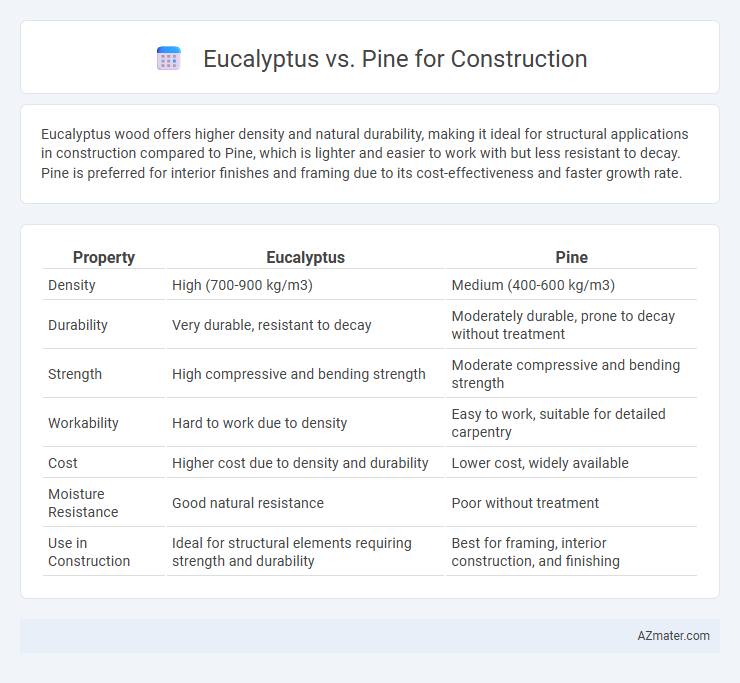Eucalyptus wood offers higher density and natural durability, making it ideal for structural applications in construction compared to Pine, which is lighter and easier to work with but less resistant to decay. Pine is preferred for interior finishes and framing due to its cost-effectiveness and faster growth rate.
Table of Comparison
| Property | Eucalyptus | Pine |
|---|---|---|
| Density | High (700-900 kg/m3) | Medium (400-600 kg/m3) |
| Durability | Very durable, resistant to decay | Moderately durable, prone to decay without treatment |
| Strength | High compressive and bending strength | Moderate compressive and bending strength |
| Workability | Hard to work due to density | Easy to work, suitable for detailed carpentry |
| Cost | Higher cost due to density and durability | Lower cost, widely available |
| Moisture Resistance | Good natural resistance | Poor without treatment |
| Use in Construction | Ideal for structural elements requiring strength and durability | Best for framing, interior construction, and finishing |
Introduction to Eucalyptus and Pine as Construction Materials
Eucalyptus and pine are prominent construction materials valued for their distinct properties and availability. Eucalyptus wood is known for its high density, durability, and resistance to pests, making it suitable for heavy structural applications. Pine, characterized by its lighter weight and ease of workability, is often favored for framing, interior finishing, and cost-effective construction projects.
Growth and Sustainability of Eucalyptus vs Pine
Eucalyptus grows significantly faster than pine, reaching harvest maturity in as little as 7-10 years compared to pine's 20-30 years, making it a more sustainable choice for rapid timber production. Its high adaptability and efficient water use contribute to reduced environmental impact, while pine plantations often require longer growth cycles and more intensive resource inputs. Choosing eucalyptus supports sustainable forestry practices by enabling frequent replanting and carbon sequestration, aligning with eco-friendly construction demands.
Mechanical Strength and Durability Comparison
Eucalyptus wood demonstrates superior mechanical strength compared to pine, with higher density and greater hardness, making it more suitable for load-bearing structures in construction. Its natural durability and resistance to decay and insect attack surpass pine, which is more prone to rot and requires chemical treatment for longevity. While pine offers easier workability and faster growth rates, eucalyptus provides enhanced structural integrity and longer service life in demanding environments.
Resistance to Pests and Decay
Eucalyptus wood exhibits superior natural resistance to pests and decay compared to pine, owing to its dense grain and high oil content that deter termites and fungal attacks. Pine, while more susceptible to insect infestation and rot, can be treated with preservatives to enhance durability in construction applications. Choosing eucalyptus for structural elements exposed to moisture and pests ensures greater longevity and reduced maintenance costs in building projects.
Workability and Ease of Processing
Eucalyptus wood offers a dense and hard texture, making it more challenging to cut and shape but providing excellent strength for construction. Pine is softer and easier to process, allowing for faster cutting, nailing, and sanding, which reduces labor time and effort on site. The workability of pine makes it preferable for intricate designs, while eucalyptus durability suits heavy-duty structural applications.
Cost and Economic Considerations
Eucalyptus offers faster growth rates and shorter harvest cycles, making it a cost-effective option for construction projects seeking quick timber supply. Pine generally has lower initial costs due to widespread availability and established market demand but may require longer maturation periods. Economic considerations also include Eucalyptus' higher density and durability, potentially reducing maintenance costs over time compared to Pine.
Environmental Impact and Carbon Footprint
Eucalyptus and pine differ significantly in environmental impact and carbon footprint when used in construction. Eucalyptus trees grow faster and sequester more carbon dioxide per hectare due to their rapid biomass accumulation, contributing to a lower carbon footprint during cultivation. Pine, commonly sourced from temperate forests, often requires longer growth cycles, resulting in slower carbon capture but is prized for its renewable properties and ease of recycling in sustainable building practices.
Availability and Sourcing Globally
Eucalyptus and pine are both widely used in construction, but their availability and sourcing differ significantly on a global scale. Pine is more abundantly available worldwide, particularly in North America, Europe, and parts of Asia, making it a cost-effective and easily sourced timber for various construction applications. Eucalyptus, native to Australia and increasingly cultivated in tropical and subtropical regions such as South America and Africa, can be less accessible but offers fast-growing and sustainable forestry options where it is locally established.
Common Construction Applications for Each Wood
Eucalyptus wood is widely used in heavy construction projects such as flooring, framing, and outdoor decking due to its high density and natural resistance to decay. Pine is commonly preferred for interior applications like furniture, paneling, and light framing because of its ease of workability and affordability. Both woods offer distinct advantages; eucalyptus is favored for durability in exterior environments, while pine excels in versatility and cost-effectiveness in indoor construction.
Summary: Choosing Between Eucalyptus and Pine
Eucalyptus offers higher density and durability, making it ideal for heavy structural applications and outdoor use due to its natural resistance to decay and insects. Pine is more affordable, lighter, and easier to work with, preferred in interior construction and decorative elements where load-bearing capacity is less critical. Selecting between eucalyptus and pine depends on specific project requirements, balancing cost, strength, and environmental exposure.

Infographic: Eucalyptus vs Pine for Construction
 azmater.com
azmater.com